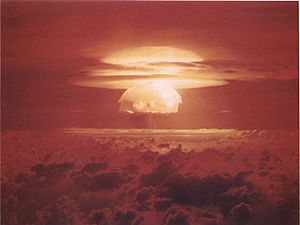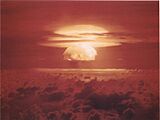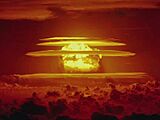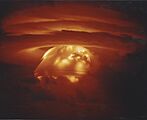Castle Bravo facts for kids
Quick facts for kids Castle Bravo |
|
|---|---|
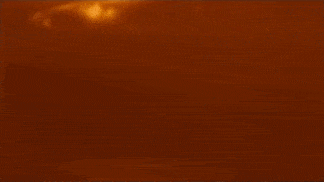
Film of the Bravo detonation and subsequent mushroom cloud
|
|
| Information | |
| Country | United States |
| Test series | Operation Castle |
| Test site | Bikini Atoll |
| Date | 1 March 1954 |
| Test type | Atmospheric |
| Yield | 15 megatons of TNT (63 PJ) |
| Navigation | |
| Previous test | Upshot–Knothole Climax |
| Next test | Castle Romeo |
Castle Bravo was a very powerful test of a new type of nuclear weapon by the United States. It happened on March 1, 1954, at Bikini Atoll in the Marshall Islands. This test was part of a bigger series called Operation Castle.
The Castle Bravo device was the strongest nuclear weapon ever set off by the United States. It was also the first time they tested a thermonuclear weapon using a special design and a fuel called lithium deuteride. The explosion was much bigger than expected. Scientists thought it would be about 6 megatons (a megaton is like a million tons of TNT). But it turned out to be 15 megatons! This huge explosion caused a lot of radioactive contamination in the area.
Radioactive dust and particles, called fallout, spread far and wide. Some of the heaviest fallout landed on nearby islands like Rongelap and Utirik. People living there had to be moved to safety three days later. They suffered from radiation sickness, which made them feel very unwell. A Japanese fishing boat, the Daigo Fukuryū Maru (meaning "Lucky Dragon No. 5"), was also caught in the fallout. Its 23 crew members became sick, and one person sadly died six months later. This event caused a lot of concern around the world about testing these powerful weapons in the atmosphere.
The giant hole left by the explosion, called the Bravo Crater, is located at 11°41′50″N 165°16′19″E / 11.69722°N 165.27194°E.
The Huge Explosion
The test device was placed on an artificial island built on a reef near Namu Island, part of Bikini Atoll. Many special cameras and tools were set up to record the explosion.
The blast happened at 6:45 AM local time on March 1, 1954.
When Bravo exploded, it created a huge fireball almost 4.5 miles (7.2 km) (7.2 kilometers) wide in just one second. People could see this bright fireball from Kwajalein Atoll, which was over 250 miles (400 km) (400 kilometers) away! The explosion left a massive crater in the reef. This crater was about 6,500 feet (2,000 m) (2 kilometers) wide and 250 feet (76 m) (76 meters) deep.
The giant mushroom cloud from the explosion shot up very quickly. In about a minute, it reached a height of 47,000 feet (14,000 m) (14.3 kilometers) and was 7 miles (11 km) (11 kilometers) wide. In less than 10 minutes, it grew even taller, reaching 130,000 feet (40 km) (40 kilometers) high and 62 mi (100 km) (62 miles) wide. The cloud was expanding at a speed of more than 160 meters per second (580 km/h; 360 mph).
Because of the blast, the cloud spread radioactive material over more than 7,000 square miles (18,000 km2) (18,000 square kilometers) of the Pacific Ocean. This included nearby small islands like Rongerik, Rongelap, and Utirik.
To give you an idea of its power, Castle Bravo was about 1,000 times stronger than the atomic bomb dropped on Hiroshima during World War II. It is the sixth largest nuclear explosion in history. Even bigger tests were done by the Soviet Union, like the Tsar Bomba, which was about 50 megatons.
Global Impact
The radioactive fallout from Castle Bravo spread traces of radioactive material far across the world. It reached places like Australia, India, Japan, and even parts of the United States and Europe. Even though it was a secret test, Castle Bravo quickly became a major international event. It led to many calls for countries to stop testing thermonuclear weapons in the atmosphere.
Health Effects
After the test, the United States Department of Energy estimated that 253 people living in the Marshall Islands were affected by the radioactive fallout. This single test exposed people in the surrounding areas to different levels of radiation. The amount of fallout from Castle Bravo was one of the highest ever recorded.
People living near the test site were exposed to high levels of radiation. Many of them experienced mild radiation sickness, which included feeling sick to their stomach, throwing up, and having diarrhea. The explosion was much stronger than expected, and the winds changed direction. This caused some of the radioactive fallout to drift over the inhabited islands of Rongelap and Utirik.
Within 52 hours, 86 people from Rongelap and 167 people from Utirik were moved to Kwajalein Atoll for medical help. Several weeks later, many people started losing their hair (alopecia) and developed skin problems.
Exposure to this fallout has been linked to a higher chance of getting certain types of cancer, such as leukemia and thyroid cancer. Scientists are still studying the connection between radiation levels and thyroid cancer. There are also links between fallout exposure and other thyroid conditions, like hypothyroidism. People in the Marshall Islands who received a lot of radiation have a much greater risk of developing cancer.
Scientists also believe there might be a link between radiation levels and how the female reproductive system works.
Gallery
See also
 In Spanish: Castle Bravo para niños
In Spanish: Castle Bravo para niños



